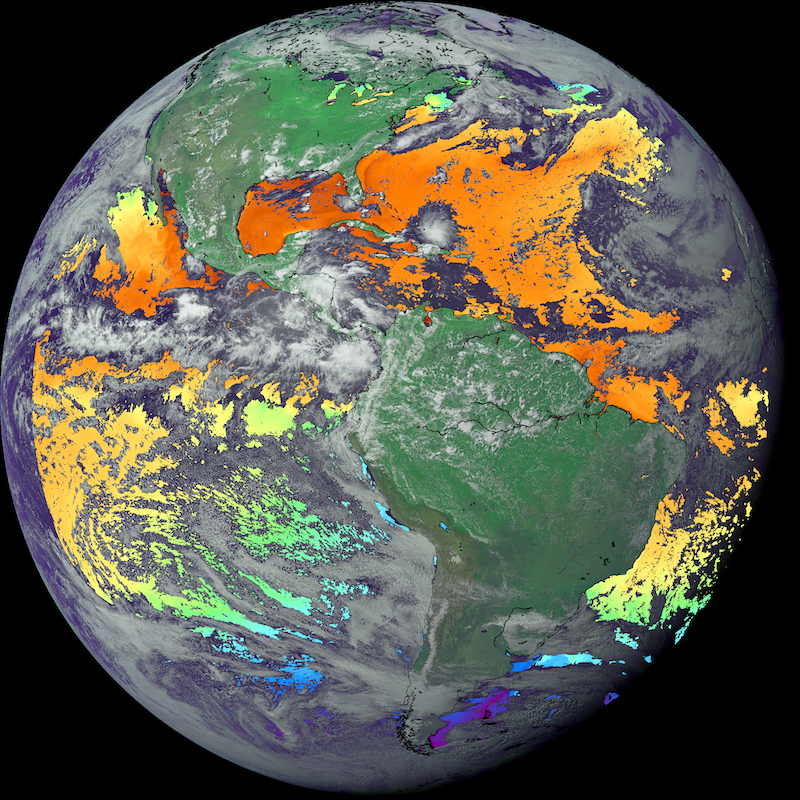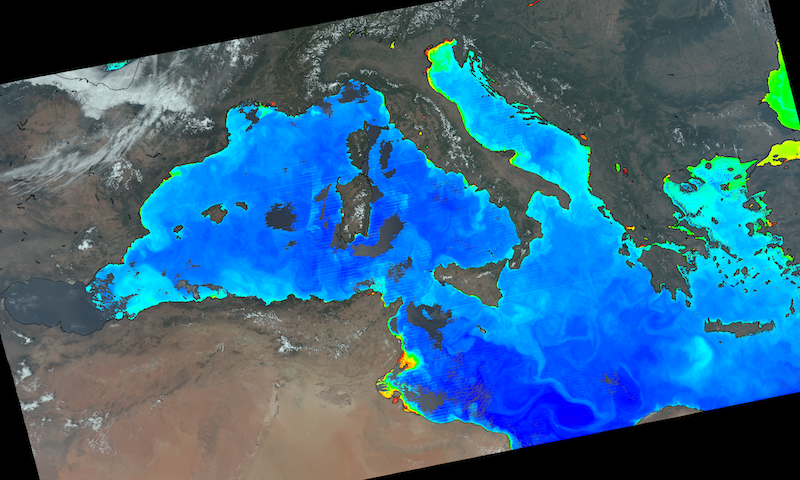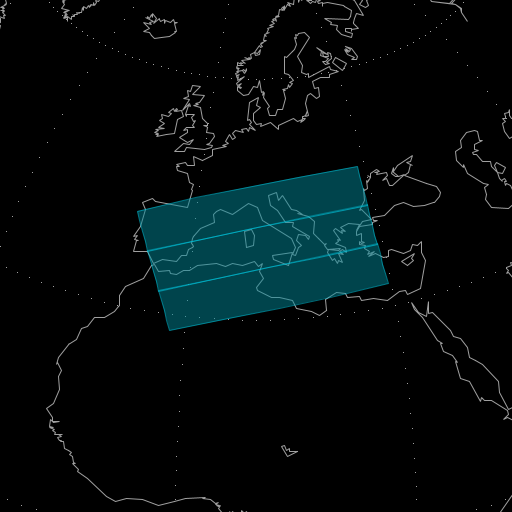Introduction
The newest CoastWatch Utilities version 3.7.1 now has a feature in
the cwrender command line tool to produce images that show both
red/green/blue composites such as true color or false color images, in
combination with a color enhancement such as SST or chlorophyll image.
In the locations where the color enhancement has no valid data, the
red/green/blue composite is used — for this reason we call it
"hybrid mode" rendering because it creates a hybrid of
different types of data.
GOES Example
The first example is a GOES image that combines three GOES visible
wavelength channels with sea surface temperature (SST) data produced
from GOES thermal wavelength channels:

All the required data must be in one HDF or NetCDF file in order for
cwrender to use it. In this example, we created an HDF file with the
following contents (this is the output from the cwinfo command):
Contents of goes_output.hdf
Global information:
Satellite: G16
Sensor: FM1
Date: 2022/07/22 JD 203
Time: 19:05:06 UTC
Scene time: day/night
Projection type: sensor_scan
Transform ident: noaa.coastwatch.util.trans.EllipsoidPerspectiveProjection
Origin: DOC/NOAA/NESDIS > U.S. Department of Commerce, National Oceanic and Atmospheric Administration, National Environmental Satellite, Data, and Information Services
Format: CoastWatch HDF version 3.4
Reader ident: noaa.coastwatch.io.CWHDFReader
Variable information:
Variable Type Dimensions Units Scale Offset
abi_ch1 short 5424x5424 W m-2 sr-1 um-1 0.812106 31.9375
abi_ch2 short 5424x5424 W m-2 sr-1 um-1 0.158592 127.937497
abi_ch3 short 5424x5424 W m-2 sr-1 um-1 0.376913 31.937498
sst short 5424x5424 kelvin 0.01 -27315
The processing steps that we used to create this file are contained
in the attached Unix script file 'goes_hybrid.sh', but your approach
to create the data file may vary from ours. The call to cwrender for
hybrid mode rendering using this data file is as follows:
cwrender \
--size 2048 --nolegends --coast black \
--composite abi_ch2/abi_ch3/abi_ch1 \
--redrange 1/600 --greenrange 1/350 --bluerange 1/800 \
--redfunction gamma --greenfunction gamma --bluefunction gamma \
--enhance sst --palette HSL256 --units celsius --range 5/35 \
goes_output.hdf goes_output.png
The --composite option specifies which variables to use in the false
color composite, and the --enhance options specifies which variable to
enhance using a color palette. The other options help the composite
and enhancement do their jobs by supplying range, function, and
palette information (see the cwrender manual page for explanations).
VIIRS Example
The next example is a VIIRS image that shows a true color composite
from three VIIRS visible wavelength channels combined with
VIIRS-derived chlorophyll data:

As in the previous example, we created an HDF data file with the
following contents:
Contents of viirs_output.hdf
Global information:
Satellite: S-NPP
Sensor: VIIRS
Date: 2022/07/22 JD 203
Start time: 12:10:27 UTC
End time: 12:14:42 UTC
Projection type: mapped
Transform ident: noaa.coastwatch.util.trans.TransverseMercatorProjection
Map projection: Transverse Mercator
Map affine: 0 -750 750 0 -1499625 899625
Spheroid: WGS 84
Origin: NOAA/NESDIS/STAR/SOCD
Format: CoastWatch HDF version 3.4
Reader ident: noaa.coastwatch.io.CWHDFReader
Variable information:
Variable Type Dimensions Units Scale Offset
EV_BandM3 float 2400x4000 mW cm^-2 um^-1 sr^-1 1 0
EV_BandM4 float 2400x4000 mW cm^-2 um^-1 sr^-1 1 0
EV_BandM5 float 2400x4000 mW cm^-2 um^-1 sr^-1 1 0
chlor_a float 2400x4000 mg m^-3 - -
The attached Unix script file 'npp_hybrid.sh' shows how we created
this file from a series of consecutive VIIRS level 2 granule files:

The cwrender call is similar to the previous example:
cwrender \
--size 2048 --nolegends --coast black \
--composite EV_BandM5/EV_BandM4/EV_BandM3 \
--redrange 0.74/60.38 --greenrange 1.68/55.87 --bluerange 2.52/61.55 \
--redfunction gamma --greenfunction gamma --bluefunction gamma \
--range 0.01/64 --enhance chlor_a --function log --palette Chlora-1 \
viirs_output.hdf viirs_output.png
In this case we used VIIRS visible channel 5/4/3 data that
corresponds to red, green, and blue wavelengths for the --composite
option, and chlorophyll data for the --enhance option. As before, the
other options help with proper data range and scaling. The ranges for
the VIIRS channel data were determined by running cwstats on the HDF
file to calculate the minimum and maximum data values:
phollema$ cwstats viirs_output.hdf
Variable Count Valid Min Max Mean Stdev Median
EV_BandM3 9600000 8517567 2.5154 61.5498 8.758797 4.459355 7.732191
EV_BandM4 9600000 8517567 1.6818 55.8729 7.228512 4.817645 5.798152
EV_BandM5 9600000 8517567 0.7442 60.3766 6.454365 6.27909 3.731425
chlor_a 9600000 3229851 0.001 391.1622 0.217629 2.406901 0.120578
